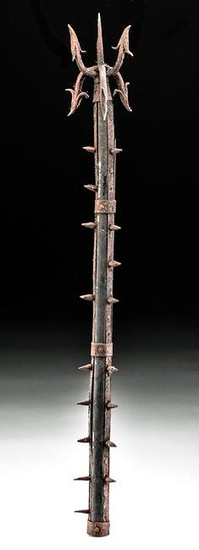Japanese Edo Wood & Iron Sodegarami Fragment
East Asia, Japan, Edo period, ca. 1603 to 1868 CE. An intimidating fragment from a polearm known as a sodegarami ("sleeve entangler") used by the samurai class in feudal Japan. This tool consists of a central wooden pole, several iron strips lined with dozens of protruding barbs, and six crescent-tipped arrow heads on top surrounding a central spear point. Despite its barbaric presentation, the sodegarami was used to capture an individual without harming them by catching the clothing fibers and tangling their arms until they could be subdued. Size: 24.4" L x 3.7" W (62 cm x 9.4 cm)
For another example of a sodegarami with a T-shaped crossbar, please see: Withers, Harvey J.S. "The Illustrated Encyclopedia of Swords and Sabres." Lorenz Books, London, 2010, p. 215, middle example.
Provenance: private J.H. collection, Beaverton, Oregon, USA, acquired in February 2006; ex-private Onomichi, Hiroshima, Japan collection
All items legal to buy/sell under U.S. Statute covering cultural patrimony Code 2600, CHAPTER 14, and are guaranteed to be as described or your money back.
A Certificate of Authenticity will accompany all winning bids.
We ship worldwide to most countries and handle all shipping in-house for your convenience.
#151951 Dimensions: Condition Report: This is the upper portion of a larger sodegarami; original lower pole body missing. Slight bending to some iron strips and top arrow points and losses to some barbs, with abrasions and nicks to wooden pole and some iron components, and light encrustations. Great patina throughout.
View it on
Sale price
Estimate
Time, Location
Auction House
East Asia, Japan, Edo period, ca. 1603 to 1868 CE. An intimidating fragment from a polearm known as a sodegarami ("sleeve entangler") used by the samurai class in feudal Japan. This tool consists of a central wooden pole, several iron strips lined with dozens of protruding barbs, and six crescent-tipped arrow heads on top surrounding a central spear point. Despite its barbaric presentation, the sodegarami was used to capture an individual without harming them by catching the clothing fibers and tangling their arms until they could be subdued. Size: 24.4" L x 3.7" W (62 cm x 9.4 cm)
For another example of a sodegarami with a T-shaped crossbar, please see: Withers, Harvey J.S. "The Illustrated Encyclopedia of Swords and Sabres." Lorenz Books, London, 2010, p. 215, middle example.
Provenance: private J.H. collection, Beaverton, Oregon, USA, acquired in February 2006; ex-private Onomichi, Hiroshima, Japan collection
All items legal to buy/sell under U.S. Statute covering cultural patrimony Code 2600, CHAPTER 14, and are guaranteed to be as described or your money back.
A Certificate of Authenticity will accompany all winning bids.
We ship worldwide to most countries and handle all shipping in-house for your convenience.
#151951 Dimensions: Condition Report: This is the upper portion of a larger sodegarami; original lower pole body missing. Slight bending to some iron strips and top arrow points and losses to some barbs, with abrasions and nicks to wooden pole and some iron components, and light encrustations. Great patina throughout.



